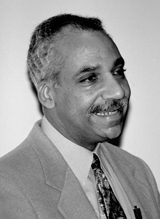The University Record, January 31, 2000
By Jane R. Elgass

Hate crimes go beyond the underlying crimes, which can range from vandalism to homicide, and because they affect entire communities they require enhanced penalties, Saul A. Green told a standing-room-only audience at the Law School Jan. 17.
Discussing “The Federal Prosecutor’s Role in Battling Violence and Hate in Society,” Green outlined the nature of the problem of hate crimes, the role of the federal prosecutor in investigation and prosecution of hate crimes, and the evolving role of prosecutors and law enforcement officials as they develop coordinated community responses to hate crimes.
Green, a U-M alumnus, is the U.S. attorney for the Eastern District of Michigan, the Justice Department’s chief official in this region. He is a member of the Attorney General’s Advisory Committee, the chair of the committee’s Violent Crime/Organized Crime Subcommittee and co-chair of the Michigan Alliance Against Hate Crimes (MIAAHC).
Uniform Crime Reporting Statistics provided by the FBI indicate that in 1998 there were 7,575 hate crime incidents nationwide, with 4,300 related to race, 1,400 to religion, 1,260 to sexual orientation and 615 to ethnicity or national origin.
“Hate crimes are not just against the victim,” Green said, “but against the whole community.” And because those committing the crimes purport to represent the community, their actions have a greater effect on the community.
A jilted boyfriend can take his car keys and scratch his girlfriend’s car. That’s an act of vandalism. Another person could scratch words offensive to someone from a different racial or ethnic background. That could be classified as a hate crime, with vandalism the underlying crime. The vandalism can be prosecuted under existing statutes, but special steps need to be taken to incorporate the hate crime aspect in penalties, Green explained.
In most crimes, Green noted, the perpetrator moves on. The message in hate crimes is that the victim should move on, out of fear that the perpetrator might surface again.
While there are no federal statutes that specifically address hate crimes, there are two laws that Green’s office uses.
Under a federal civil rights statute concerning civil rights and federally protected activities (124556 18 U.S.C.A. 245), individuals cannot be denied from “enjoying or attempting to enjoy” certain rights based on race, ethnicity, national origin or religion. The rights include voting or qualifying to vote; using services, programs and facilities provided by government; applying for employment; serving on juries; enrolling in or attending public schools or colleges; traveling or using facilities of interstate commerce; and using the goods and services of places of public accommodation. The statute does not cover sexual orientation, gender or disability.
The Fair Housing Act prohibits interference in individuals’ rights in the purchase, use or occupancy of housing.
Green noted that amendments to “245” have been pending for two years. The amendments would add sexual orientation, gender and disability and would remove the six rights listed above, thereby removing limitations imposed by those categories.
Green cited MIAAHC as an example of nationwide efforts to develop a coordinated approach to dealing with hate crimes.
MIAAHC was formed in 1998 after the Michigan Department of Civil Rights approached Green for help in creating such a collaborative effort, and its five sub-committees provide a structure for attacking bias crimes.
The community response sub-committee helps communities create local versions of MIAAHC. The data collection and trend analysis group provides information that gives officials a sense of the magnitude of the problem, and it is working on developing common definitions. The education and public awareness sub-committee is the prevention arm of the umbrella group. “Prevention is as important as enforcement,” Green noted. “We want to cut off the act before it occurs.”
The enforcement and training group provides assistance to communities to ensure that suspected hate crimes are properly investigated. MIAAHC also has a victim support group.
Ongoing training is being offered to law enforcement officers all over the state, Green said. “They have to recognize hate crime in their own communities, detect that it is a hate crime and bring a response team in,” he added.
Having viewed videos of 1950s and 1960s civil rights marches at a Focus Hope program earlier in the day, Green noted that there is a marked difference in the role law enforcement plays in hate crimes compared with the past 30 years.
In those days, he said, law enforcement was either passive in response to hate crimes, or sometimes even a participant. “Today law enforcement is stepping up to bring the community together to respond with a common voice,” he noted.
Green’s presentation was sponsored by the Law School and co-sponsored by the Asian Pacific American Law Students Association, Asylum and Refugee Law Project, Black Law Students’ Association, Latino Law Students’ Association, Michigan Journal of Gender and Law, Michigan Journal of International Law, Michigan Journal of Race and Law, Public Interest Group, Women Law Students’ Association and the Law School’s Office of Academic Services.

